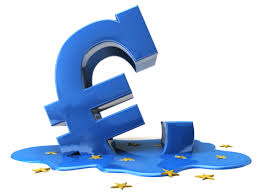European leaders and central bankers have been saying for years that their economic policies would soon revive the economies of the eurozone. It seems that investors have finally stopped believing those fairy tales.
The euro has been sliding against the dollar for much of the last 12 months and, this week, fell to a nine-year low, after the European Union published depressing economic data. One euro was trading at $1.1815 Thursday afternoon, down from $1.3588 at the start of 2013. The currency has fallen because of a growing fear among investors that the eurozone — 19 countries — is stuck in an economic quagmire. Its leaders are not doing much to pull it out.
For a time, European leaders like Chancellor Angela Merkel of Germany found a convenient excuse in the weakened economies of Greece, Spain, Ireland and Portugal. Their argument went something like this: Europe will rebound once politicians in countries on the “periphery” of the eurozone streamline their systems and reduce their deficits. The nations did much of what was asked: They made severe cuts to public services, pensions and other spending; passed laws to make it easier for companies and governments to fire people; and raised taxes.
Some of these peripheral nations are indeed growing again. But the sacrifices they have been forced to make have come at great cost to them. In Greece and Spain, unemployment remains very high, at about 25 percent, and deflation, which is defined as a broad decline in consumer prices, has been a reality for months.
Meanwhile, the problems of the periphery have metastasized and now even the “core” is faltering. Unemployment has stopped falling and remains high in most eurozone nations. Consumer prices declined by 0.2 percent in December, the first time they have fallen across the currency union since 2009. Germany, France and Italy — its three largest economies — contracted or barely grew in the second and third quarters of 2014.
And there is little reason to expect a quick recovery since the governments of these nations are doing little or nothing to help. A recently announced European Union investment fund, for example, is so small that it will not come close to replacing the drop in government and private capital spending since the crisis. Officials at the European Central Bank, who helped stabilize the eurozone in recent years, have been saying they will do more by, for instance, buying bonds and other assets that would pump money into the economy, but they have not yet delivered.
Given this grim backdrop, the euro’s tumble is to be expected. The Japanese yen and the British pound have also slid against the dollar in recent months as their countries’ economies have lagged that of the United States. For Americans, a weaker euro will lower the cost of European vacations, wine and cheese. But the region’s frail economy will reduce demand for American goods and services, undermining the modest recovery here.
If anything, the euro’s decline should serve as a mini-economic stimulus because it lowers the cost of goods and services produced in the zone for consumers in the rest of the world. A depreciating currency will, of course, make imports costlier. But that is desirable because inflation is already so low in the eurozone. The currency markets are telling us something important: European leaders are not doing enough.



















